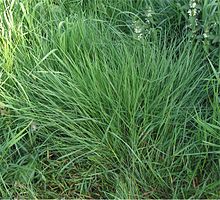- Agrostis capillaris
-
Colonial Bentgrass 
Scientific classification Kingdom: Plantae Division: Magnoliophyta Class: Liliopsida Order: Cyperales Family: Poaceae Genus: Agrostis Species: A. Capillaris Binomial name Agrostis Capillaris
L.Synonyms[1][2] - Agrostis sylvatica Huds.
- Agrostis tenuis Sibth.
- Agrostis tenuis Sibth. var. aristata (Parn.) Druce
- Agrostis tenuis Sibth. var. hispida (Willd.) Philipson
- Agrostis tenuis Sibth. var. pumila (L.) Druce
- Agrostis vulgaris With.
- Agrostis alba var. vulgaris (With.) Coss. & Durieu
Agrostis capillaris (Common Bent,Colonial bent, Browntop) is a rhizomatous and stoloniferous perennial in the grass family (Poaceae). It is native to Eurasia and has been widely introduced in many parts of the world.[3] Colonial bent grows in moist grasslands and open meadows, and can also be found in agricultural areas, roadsides, and invading disturbed areas.[4]
The name agrostis comes from the Greek word meaning forage plant, agros meaning 'a field'.
It is found growing in neutral to acidic soils. It has a very fine texture and like most bent grasses grows very dense. Although this species has been used on golf courses and sporting fields it is better suited for lawns. Colonial Bent is fairly easy to grow from seeds and fertilization of the lawn is not as intense. This grass also takes longer to establish than Creeping Bent. However it does not require the intense maintenance.[5]
Many internet sources describe it as being the tallest of the bent species. However C E Hubbard describes its height as ranging from 10 to 70cm high, whereas the Black Bent Agrostis gigantea is 40 to 120 cm. Marjorie Blamey, Richard and Alastair Fitter also describe Black Bent as being taller[6][7].
Physical description
It forms a dense sward of fine leaves. The ligule is short and does not come to a point. This differs from Creeping Bent, Agrostis stolonifera which is pointed and up to 5mm long.
The flowering panicles appear from May until June. They are finely branched and look like a purple haze from a distance. The panicle persists in winter after the seeds have been shed.[8]
References
- ^ Plants Profile for Agrostis Capillaris Retrieved 2010-03-14.
- ^ Germplasm Resource Information Network Retrieved 2010-03-15.
- ^ Grass Manual on the Web Retrieved 2010-03-15.
- ^ Global Invasive Species Database: Ecology of Agrostis capillaris Retrieved 2010-03-15.
- ^ Watson L, Dallwitz MJ. (2008). "The grass genera of the world: descriptions, illustrations, identification, and information retrieval; including synonyms, morphology, anatomy, physiology, phytochemistry, cytology, classification, pathogens, world and local distribution, and references". The Grass Genera of the World. http://delta-intkey.com/grass/www/agrostis.htm. Retrieved 2009-08-19.
- ^ Grasses by C E Hubbard, 1978, published by Penguin books
- ^ Wild Flowers of Britain and Ireland|author=Marjorie Blamey, Richard and Alistair Fitter|year=2003|ISBN=0-7136-5944-0
- ^ BSBI Description retrieved 2010-11-16.
External links
- Garden Organic Website for a detailed description
This Pooideae article is a stub. You can help Wikipedia by expanding it. - Agrostis sylvatica Huds.
